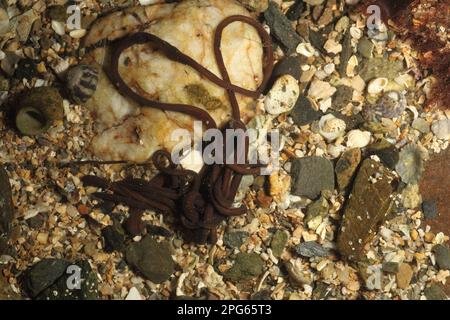
Bootlace worms, or *Lineus longissimus*, might not be the first thing that comes to mind when you think of marine life. Picture a long, squirmy ribbon—these worms can grow over 30 meters! That’s about the length of a blue whale, making them one of the longest animals in the world. But what really sets them apart is how they behave when the tide ebbs away. These worms have fascinating survival strategies that come into play during low tide, and we’re going to explore those strategies, as well as a few surprising facts about this incredible species.
What Exactly Are Bootlace Worms?
Before we jump into their low-tide behavior, let’s get to know bootlace worms a bit better. Bootlace worms belong to the phylum Annelida, which means they’re segmented worms. Imagine a long train made of small, connected cars—that’s kind of how their bodies are structured!
These worms are typically found in the shallow coastal waters of the North Atlantic. They usually hang out in marine environments, like muddy or sandy seabeds. So, if you were to dig a little in some coastal mud, you might just find one of these fascinating creatures hiding away.
What’s truly incredible is their ability to regenerate. If a bootlace worm loses a segment of its body, it can grow that segment back, just like how a lizard regrows its tail. This regeneration ability is key to their survival, especially when faced with environmental challenges.
Bootlace Worms at Low Tide
When the tide goes out, bootlace worms have some interesting tactics to cope with the change in their environment. Unlike many marine animals that might struggle with low water levels, these worms are quite adaptable. They can often be found wriggling around, trying to find some good hiding spots to escape the drying conditions.
During low tide, you might see bootlace worms burying themselves in the sand or mud. This behavior helps them retain moisture and avoid serious dehydration. Picture a turtle retreating into its shell; similarly, these worms slip into the ground to protect themselves. It’s their version of “hunkering down” until the tide comes back in!
Additionally, they utilize their length to their advantage. When exposed, you can see them stretching out in the sand, almost like an underground wave. Their bodies are so flexible that they can maneuver through the tiniest gaps in the sand, making it harder for predators to spot them.
The Unique Feeding Habits of Bootlace Worms
Now, you might be wondering about what bootlace worms munch on during low tide. These worms are mainly carnivorous, feasting on small invertebrates. When the tide is up, they can easily hunt. But when it’s low, they’ve got to be a bit creative.
A common strategy is to filter-feed. Bootlace worms can extend their bodies out, capturing tiny particles and prey from the water that’s still hanging around their sandy home. They use their incredible length to reach out and snag food, almost like a fishing line casting for dinner.
This ability to switch between hunting and filter-feeding makes them highly versatile. If food is scarce or if they’re in a pinch, they can rely on this method to survive until the tide comes back in.
Why Low-Tide Behavior Matters
Understanding how bootlace worms behave during low tide isn’t just interesting—it also helps us grasp how these organisms interact with their ecosystems. When the tide pulls back, many animals face challenges. But bootlace worms have evolved to adapt, showcasing nature’s amazing resilience.
This adaptability can serve as an indicator of environmental health. If bootlace worms start to decline, it could signal problems in their habitat, such as pollution or climate change. So, studying their behavior during low tide gives scientists valuable insights into the state of coastal ecosystems.
Additionally, these worms play a role in their community. As both predators and prey, they contribute to the balance of marine life. Smaller fish and crabs may hunt them, while they help control the population of the tiny creatures they eat. It’s a delicate balance that highlights the interconnectedness of life beneath the waves.
Common Myths About Bootlace Worms
You might hear some wild tales about bootlace worms, especially considering their unusual size and shape. One common myth is that they can be dangerous or venomous. While they can wiggle and squirm, these worms are not harmful to humans. They primarily stick to their small prey in the mud and sand, so there’s no need to fear if you happen to see one.
Another myth is that bootlace worms are solely marine creatures. In reality, while they thrive in the ocean, they can also adapt to brackish waters—places where fresh and saltwater mix. This adaptability is a hallmark of their survival strategy.
Understanding these myths helps us appreciate bootlace worms better and realize how much we still have to learn about the creatures that share our planet.
So, the next time you find yourself wandering along the shore during low tide, take a moment to think about what’s happening beneath your feet. Bootlace worms, with their incredible length and fascinating behavior, are just one example of how life thrives in challenging environments. Their ability to adapt, feed, and survive places them in a unique position within the marine ecosystem.
Whether you’re a marine enthusiast or just someone who enjoys beach walks, keep an eye out for these remarkable creatures. They remind us of the wonders of nature and how interconnected life can be, even in the most surprising forms. From their low-tide strategies to their sophisticated feeding habits, bootlace worms truly embody resilience in the face of environmental challenges.
